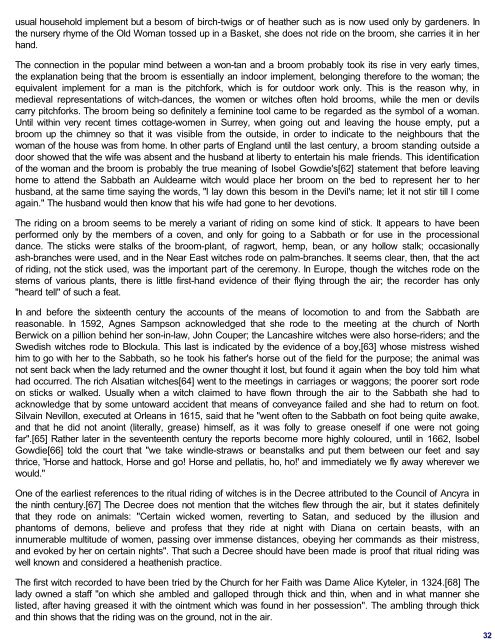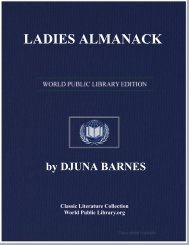THE GOD OF THE WITCHES - World eBook Library - World Public ...
THE GOD OF THE WITCHES - World eBook Library - World Public ...
THE GOD OF THE WITCHES - World eBook Library - World Public ...
You also want an ePaper? Increase the reach of your titles
YUMPU automatically turns print PDFs into web optimized ePapers that Google loves.
usual household implement but a besom of birch-twigs or of heather such as is now used only by gardeners. In<br />
the nursery rhyme of the Old Woman tossed up in a Basket, she does not ride on the broom, she carries it in her<br />
hand.<br />
The connection in the popular mind between a won-tan and a broom probably took its rise in very early times,<br />
the explanation being that the broom is essentially an indoor implement, belonging therefore to the woman; the<br />
equivalent implement for a man is the pitchfork, which is for outdoor work only. This is the reason why, in<br />
medieval representations of witch-dances, the women or witches often hold brooms, while the men or devils<br />
carry pitchforks. The broom being so definitely a feminine tool came to be regarded as the symbol of a woman.<br />
Until within very recent times cottage-women in Surrey, when going out and leaving the house empty, put a<br />
broom up the chimney so that it was visible from the outside, in order to indicate to the neighbours that the<br />
woman of the house was from home. In other parts of England until the last century, a broom standing outside a<br />
door showed that the wife was absent and the husband at liberty to entertain his male friends. This identification<br />
of the woman and the broom is probably the true meaning of Isobel Gowdie's[62] statement that before leaving<br />
home to attend the Sabbath an Auldearne witch would place her broom on the bed to represent her to her<br />
husband, at the same time saying the words, "I lay down this besom in the Devil's name; let it not stir till I come<br />
again." The husband would then know that his wife had gone to her devotions.<br />
The riding on a broom seems to be merely a variant of riding on some kind of stick. It appears to have been<br />
performed only by the members of a coven, and only for going to a Sabbath or for use in the processional<br />
dance. The sticks were stalks of the broom-plant, of ragwort, hemp, bean, or any hollow stalk; occasionally<br />
ash-branches were used, and in the Near East witches rode on palm-branches. It seems clear, then, that the act<br />
of riding, not the stick used, was the important part of the ceremony. In Europe, though the witches rode on the<br />
stems of various plants, there is little first-hand evidence of their flying through the air; the recorder has only<br />
"heard tell" of such a feat.<br />
In and before the sixteenth century the accounts of the means of locomotion to and from the Sabbath are<br />
reasonable. In 1592, Agnes Sampson acknowledged that she rode to the meeting at the church of North<br />
Berwick on a pillion behind her son-in-law, John Couper; the Lancashire witches were also horse-riders; and the<br />
Swedish witches rode to Blockula. This last is indicated by the evidence of a boy,[63] whose mistress wished<br />
him to go with her to the Sabbath, so he took his father's horse out of the field for the purpose; the animal was<br />
not sent back when the lady returned and the owner thought it lost, but found it again when the boy told him what<br />
had occurred. The rich Alsatian witches[64] went to the meetings in carriages or waggons; the poorer sort rode<br />
on sticks or walked. Usually when a witch claimed to have flown through the air to the Sabbath she had to<br />
acknowledge that by some untoward accident that means of conveyance failed and she had to return on foot.<br />
Silvain Nevillon, executed at Orleans in 1615, said that he "went often to the Sabbath on foot being quite awake,<br />
and that he did not anoint (literally, grease) himself, as it was folly to grease oneself if one were not going<br />
far".[65] Rather later in the seventeenth century the reports become more highly coloured, until in 1662, Isobel<br />
Gowdie[66] told the court that "we take windle-straws or beanstalks and put them between our feet and say<br />
thrice, 'Horse and hattock, Horse and go! Horse and pellatis, ho, ho!' and immediately we fly away wherever we<br />
would."<br />
One of the earliest references to the ritual riding of witches is in the Decree attributed to the Council of Ancyra in<br />
the ninth century.[67] The Decree does not mention that the witches flew through the air, but it states definitely<br />
that they rode on animals: "Certain wicked women, reverting to Satan, and seduced by the illusion and<br />
phantoms of demons, believe and profess that they ride at night with Diana on certain beasts, with an<br />
innumerable multitude of women, passing over immense distances, obeying her commands as their mistress,<br />
and evoked by her on certain nights". That such a Decree should have been made is proof that ritual riding was<br />
well known and considered a heathenish practice.<br />
The first witch recorded to have been tried by the Church for her Faith was Dame Alice Kyteler, in 1324.[68] The<br />
lady owned a staff "on which she ambled and galloped through thick and thin, when and in what manner she<br />
listed, after having greased it with the ointment which was found in her possession". The ambling through thick<br />
and thin shows that the riding was on the ground, not in the air.<br />
32















